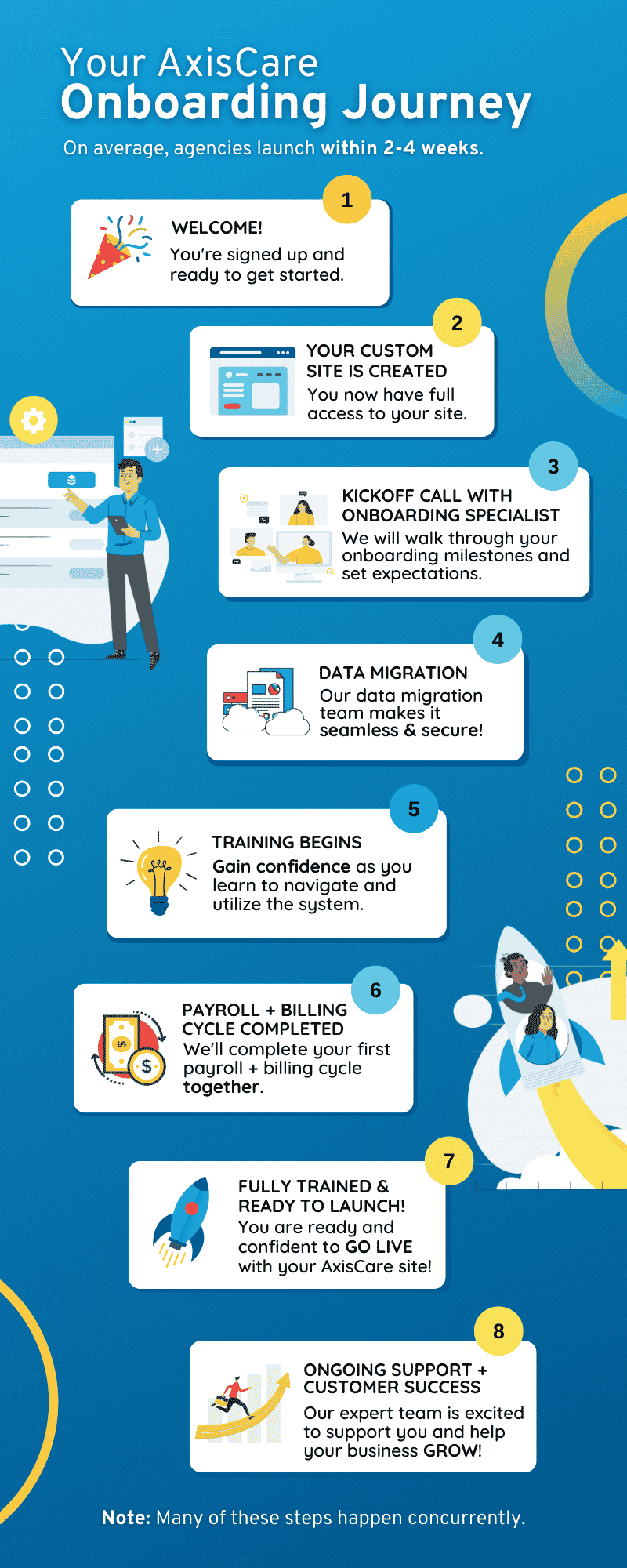In the world of home healthcare, ensuring quality care and accurate documentation is essential. Electronic Visit Verification (EVV) has emerged as a crucial tool for organizations and agencies to enhance transparency, streamline processes, and improve the overall care experience for caregivers and patients. From understanding what EVV entails to implementing it successfully, we are here to help you and cover everything you need to know to navigate this essential technology.
What is Electronic Visit Verification (EVV)?
Electronic Visit Verification (EVV) refers to a system that digitally captures and documents an in-home caregiver’s arrival and departure times at a patient’s residence. It ensures accuracy in tracking visits while minimizing errors associated with manual documentation. By leveraging EVV software, agencies can streamline operations, enhance caregiver accountability, improve patient outcomes, and ensure compliance with regulatory requirements.
Who Needs EVV?
EVV is a valuable asset for various stakeholders in home healthcare services and is typically required for agencies and organizations that provide home healthcare services. This includes home health agencies (HHAs), personal care services (PCS), home care agencies, hospice providers, and adult day care centers. Implementing EVV offers numerous advantages for these entities by promoting transparency, reducing fraud and abuse risks, enhancing care coordinate, and optimizing workflow efficiency.
How Does EVV Work?
At its core, EVV relies on robust software solutions that enable caregivers to document their visits electronically. These systems leverage various technologies such as a mobile app or telephony-based solutions to capture essential data during each visit. This includes information like date/time stamps, caregiver identity verification through unique identifiers or PINs, location verification through GPS tracking or caller ID recognition systems.
By capturing this data in real-time and transmitting it securely to an agency’s central system or electronic health record (EHR), electronic visit verification software can provide accurate documentation of services rendered while minimizing errors or discrepancies commonly associated with traditional paper-based methods.
Implementation of EVV in Home Healthcare
Implementing EVV in home healthcare requires careful planning and attention to detail. Let’s explore the key stages involved in a successful implementation:
Planning for EVV Implementation
This stage sets the foundation for a smooth implementation process. It involves identifying stakeholders who will be involved in the implementation journey, assessing the agency’s readiness for change, setting clear goals and objectives for implementing EVV, and developing a comprehensive implementation plan.
Selecting an EVV Solution
Choosing the right electronic visit verification software is crucial for seamless integration into your existing systems and workflows. Considerations should include compliance requirements specific to your region or agency policies, usability and user-friendliness of the software, system features that align with your needs (such as scheduling capabilities or reporting functionalities), availability of technical support from vendors, data security measures implemented by the solution provider, cost considerations, and the reputation and experience of the software provider.
Types of EVV Solutions
Various EVV solutions are available in the market today, each offering unique features and benefits. The choice of an EVV solution largely depends on the specific needs and circumstances of the home healthcare agency. Some common features of EVV software include:
- Mobile Applications: These are applications installed on smartphones or tablets. They utilize GPS technology to verify visit location and record timestamps for arrivals and departures.
- Telephony Visit Verification (TVV): This system requires caregivers to check-in and check-out using the patient’s landline phone.
- Fixed Visit Verification Devices (FVV): These are specialized devices installed at the patient’s home that caregivers interact with to record their visits.
- Electronic Health Records (EHR): EHR-based EVV solutions integrate visit verification directly into the patient’s electronic health record.
- Integrated Solutions: These encompass a comprehensive suite of functionalities, combining EVV with other aspects of home healthcare management, such as scheduling, billing, and reporting.
- Wearable Devices: These are portable devices worn by patients that caregivers can interact with to verify their visits and offer the added benefit of tracking vital signs and alerting caregivers or families to any concerning health changes.
- Combination Solutions: These are hybrid solutions that combine different types of EVV technology to fit the unique needs of an agency or patient.
Vendor Options
When evaluating EVV software solutions, you’ll want to consider several critical factors to ensure you’re selecting a vendor that aligns with your agency’s needs and values:
- Functionality and Features: Look for functionality that matches your agency’s specific needs, such as HIPAA-compliant communication, documentation, real-time data transmission, etc.
- Security and Data Privacy: The vendor should demonstrate robust data security measures to protect sensitive patient and caregiver information.
- Vendor Experience and Reputation: Consider the vendor’s track record and reputation in the industry. Well-regarded vendors are often more reliable.
- Vendor Support and Training: Check if the vendor offers comprehensive support and training to ensure smooth implementation and ongoing use.
Establishing Operating Procedures
Once an electronic visit verification solution is selected, it’s essential to establish clear operating procedures that outline how caregivers will use the system, what data should be documented during visits, and how agencies will utilize the information gathered through EVV. This step ensures consistency in data collection and adherence to best practices.
Integrating EVV into Existing Systems
Integrating EVV software with your agency’s existing systems, such as electronic health records or billing software, can streamline processes and enhance efficiency. This step may require collaboration with IT departments or external vendors to ensure seamless communication between different systems.
Testing and Piloting EVV Implementation
Before fully rolling out EVV across your agency, it’s recommended to conduct testing and piloting phases. This allows for fine-tuning any operational issues or technical challenges before widespread adoption. Engaging caregivers in the testing process can provide valuable feedback and help identify areas for improvement.
Factors to Consider in Choosing an EVV Solution
When selecting an EVV software for your home healthcare agency, several factors should be taken into account:
Compliance Requirements
Ensure that the chosen EVV solution meets all relevant compliance requirements specific to your region or agency policies. This may include adherence to privacy regulations or industry standards. Non-compliance can lead to penalties and loss of funding.
Usability and User-Friendliness
Select an EVV software that is intuitive and user-friendly for caregivers. A well-designed interface can minimize training time and reduce the likelihood of errors during usage.
System Features and Interoperability
Consider the features offered by different solutions and assess their alignment with your agency’s needs. Look for functionalities like scheduling capabilities, reporting options, integration possibilities with existing systems (such as electronic health records), or compatibility with mobile devices commonly used by caregivers.
Implementation and Support
Evaluate the level of support provided by the vendor during the implementation stages. Ensure they offer comprehensive training resources, responsive technical support, and ongoing assistance to address any issues that may arise.
Data Security and Privacy
Data security is crucial when working with sensitive patient information. Choose an electronic visit verification software that employs robust security measures, such as data encryption, secure communication channels, and compliance with privacy regulations.
Cost and ROI
Consider the financial implications of implementing an EVV system. Evaluate the upfront costs, ongoing fees, and potential return on investment (ROI) through efficiency gains, reduced paperwork burden, and improved billing accuracy.
Importance of EVV in Home Healthcare Agencies
Electronic visit verification brings numerous benefits to home healthcare agencies:
- Improved accuracy in documenting patient visits, ensuring appropriate care delivery
- Streamlined administrative processes related to scheduling, billing, and payroll
- Compliance with regulatory requirements regarding service documentation
- Real-time access to visit data for effective decision-making and resource allocation
- Potential cost savings through increased operational efficiency
Try AxisCare EVV Software Today
The right EVV software can make a positive impact on patients, caregivers, and agencies. Request a demo and see how AxisCare can help your agency be an industry leader in compliance, caregiver solutions, and client care.









